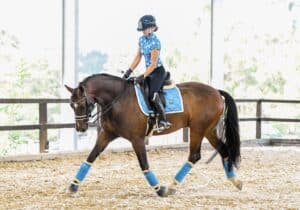The Wonders of Warm Up
The warm up is where we prepare the horse physically and mentally for the more intense work to come, writes NICOLE TOUGH.

The mental reasons are to achieve ‘losgelassenheit’ as soon as possible. A relaxed horse can hear, listen and respond to cues and signals; whereas a tense horse is surrounded by white noise and has trouble focusing. A helpful tip to promote relaxation is to find a warm up routine and then use it at every training session, keeping it the same for competition. This way, thinking same ol’, same ol’, the horse lets us in quicker.
Another tip involves discipline. The warm up is the trainer’s chance to set the intentions for the session. Start fussy, remain fussy. Every transition counts. Don’t ride aimlessly. Give them a job to do. Structure the warm up like you structure your session and be clear about its objectives, which are to achieve:
- attentiveness and immediate response to the aids; and
- suppleness through the poll joint and the whole body.
Regarding the response to our aids, the exercises we use in the warm up will depend on the horse’s personality. Some horses are energy savers and will need exercises to wake up; whilst others are overthinkers, and will need exercises that encourage patience. With either type, we should use targeted questions to produce the best response to the leg, seat and rein aids; and regardless of type, the horse needs to be ready and willing to go forward, yet totally respectful of the brakes.
A walk lap on each rein and a ‘normal’ trot should start each training session. Not only for the benefit of ongoing soundness, but also to establish balance before adding impulsion (the gears). If ridden too forward in the beginning, the horse can rush, becoming strong in the contact because they are balanced more on the forehand than we would like.
From balanced ‘normal’ gaits, we can develop understanding between the gas and the brake with lots of transitions and by consistently opening and closing the steps. The focus for the spicy type is to promote the idea of waiting by using a lot of transitions and a slowly posting trot; whilst for the energy saver, it’s to get them thinking forward (can I go now?) and in front of the leg, with as many tune ups to the gas as required.
By fine tuning responses to the leg, seat, and rein aids, we can shift their balance more to the hind leg, achieving self-carriage and having them ready for more intense work. In other words, first organise the muscles of the neck and back, and then engage more. Regarding suppleness – and no matter the stage of training, from young horses to FEI – we start the horse deep and round, seeking contact, and supple through the poll to the left and right.
Having said this, every horse is different and may need a different point of balance depending on its confirmation. Find the most productive frame where the horse becomes looser and more supple. When a horse is using their back, they can stretch in all the paces. Think about the feelings underneath you: is the horse leaning or becoming heavier on the rein in general or in any of the transitions? These are evasions, and not a true indication of seeking contact and achieving the benefits of topline connection and muscular stretching.
Interestingly, and I digress, but once the warm up lower frame is understood, the rider can use this frame to trigger relaxation whenever the horse becomes tense or tight, or when introducing a new movement. If the stretch is truly understood by the rider and the horse, it can be used as a way to diffuse tension and build confidence.

The stretch down, when performed correctly, is also a test of self-carriage. At any point in a session, or within a movement, the rider should be able to invite the horse to stretch and seek the contact without losing self-carriage. Ergo, achieving the lower frame in self-carriage is proof of relaxation and balance.
For competition warm ups, we need to know how long it takes to make our horse supple, both laterally and longitudinally. The competition warm up must be dedicated to not surprising the horse in the arena, but rather to give them a heads up about what is expected in the test, whilst preserving their legs and the petrol for the competition.
Ultimately, we use the warm up to engage the horse’s mind, asking lots of questions to achieve teamwork and willing co-operation. As a result, we can tell our horse that they are here to do great things today. So, let’s do it!


